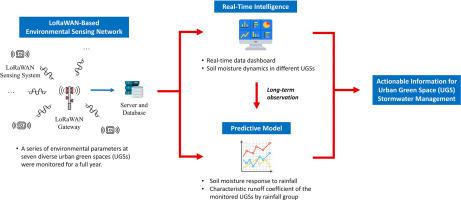基于 LoRaWAN 的环境传感网络,用于城市绿地监测和雨水管理示范应用
IF 10.5
1区 工程技术
Q1 CONSTRUCTION & BUILDING TECHNOLOGY
引用次数: 0
摘要
监测城市绿地(UGS)对于实现城市可持续发展和生态恢复至关重要。利用 LoRaWAN 技术,我们开发并实施了一套无线环境传感系统,对七个不同的城市绿地进行了为期一年的土壤湿度动态监测。分析结果表明,土壤水分受植被类型、土壤条件和物理环境的影响存在明显差异。季节性趋势表明,一些 UGS 的夏季土壤湿度较低,原因是蒸散量增加;而另一些 UGS 的土壤湿度较高,原因是灌溉次数增加。对土壤水分对降雨的响应进行了定量建模,结果表明土壤水分的增加与降雨量呈高度正相关,而与初始湿度呈负相关。在大多数情况下,这两个因素都具有显著性(p<0.001),除一个节点外,模型的调整 R2 值均高于 0.65。研究结果还揭示出,与政府指导值相比,UGS 径流系数的动态范围更大,尤其是 50 毫米以上降雨事件的径流系数较高(0.4 至 1.0)。因此,尽管现有的地下综合管廊可以帮助吸收较小的暴雨,但地下综合管廊仍需要积极的排水系统来应对极端事件。这项研究强调了 LoRaWAN 在城市环境监测方面的功效,并为管理和优化 UGS(尤其是雨水管理)提供了宝贵的见解。本文章由计算机程序翻译,如有差异,请以英文原文为准。

A LoRaWAN-based environmental sensing network for urban green space monitoring with demonstrated application for stormwater management
Monitoring urban green spaces (UGSs) is crucial for achieving sustainable urban development and ecological resilience. Leveraging LoRaWAN technology, a wireless environmental sensing system was developed and implemented to monitor soil moisture dynamics across seven diverse UGSs over a year. Analyses revealed notable variations in soil moisture influenced by vegetation types, soil conditions and physical settings. Seasonal trends indicated lower summer soil moisture in some UGSs resulting from increased evapotranspiration, while others maintained higher soil moisture due to more frequent irrigation. The soil moisture response to rainfall was quantitatively modeled, demonstrating the increase in soil moisture is highly positively dependent on rainfall amount and negatively dependent on initial moisture level. Both factors were significant (p<0.001) in most cases, and the models’ adjusted R2 values were all above 0.65 except for one node. The findings also unveiled more dynamic ranges of UGS runoff coefficients than government guideline values, especially high runoff coefficients (0.4 to 1.0) for rainfall events above 50 mm. Therefore, although existing UGSs can help absorb smaller storms, proactive drainage systems are needed for UGSs to handle extreme events. The study highlights LoRaWAN's efficacy in urban environmental monitoring and provides valuable insights for managing and optimizing UGSs, especially in stormwater management.
求助全文
通过发布文献求助,成功后即可免费获取论文全文。
去求助
来源期刊

Sustainable Cities and Society
Social Sciences-Geography, Planning and Development
CiteScore
22.00
自引率
13.70%
发文量
810
审稿时长
27 days
期刊介绍:
Sustainable Cities and Society (SCS) is an international journal that focuses on fundamental and applied research to promote environmentally sustainable and socially resilient cities. The journal welcomes cross-cutting, multi-disciplinary research in various areas, including:
1. Smart cities and resilient environments;
2. Alternative/clean energy sources, energy distribution, distributed energy generation, and energy demand reduction/management;
3. Monitoring and improving air quality in built environment and cities (e.g., healthy built environment and air quality management);
4. Energy efficient, low/zero carbon, and green buildings/communities;
5. Climate change mitigation and adaptation in urban environments;
6. Green infrastructure and BMPs;
7. Environmental Footprint accounting and management;
8. Urban agriculture and forestry;
9. ICT, smart grid and intelligent infrastructure;
10. Urban design/planning, regulations, legislation, certification, economics, and policy;
11. Social aspects, impacts and resiliency of cities;
12. Behavior monitoring, analysis and change within urban communities;
13. Health monitoring and improvement;
14. Nexus issues related to sustainable cities and societies;
15. Smart city governance;
16. Decision Support Systems for trade-off and uncertainty analysis for improved management of cities and society;
17. Big data, machine learning, and artificial intelligence applications and case studies;
18. Critical infrastructure protection, including security, privacy, forensics, and reliability issues of cyber-physical systems.
19. Water footprint reduction and urban water distribution, harvesting, treatment, reuse and management;
20. Waste reduction and recycling;
21. Wastewater collection, treatment and recycling;
22. Smart, clean and healthy transportation systems and infrastructure;
 求助内容:
求助内容: 应助结果提醒方式:
应助结果提醒方式:


